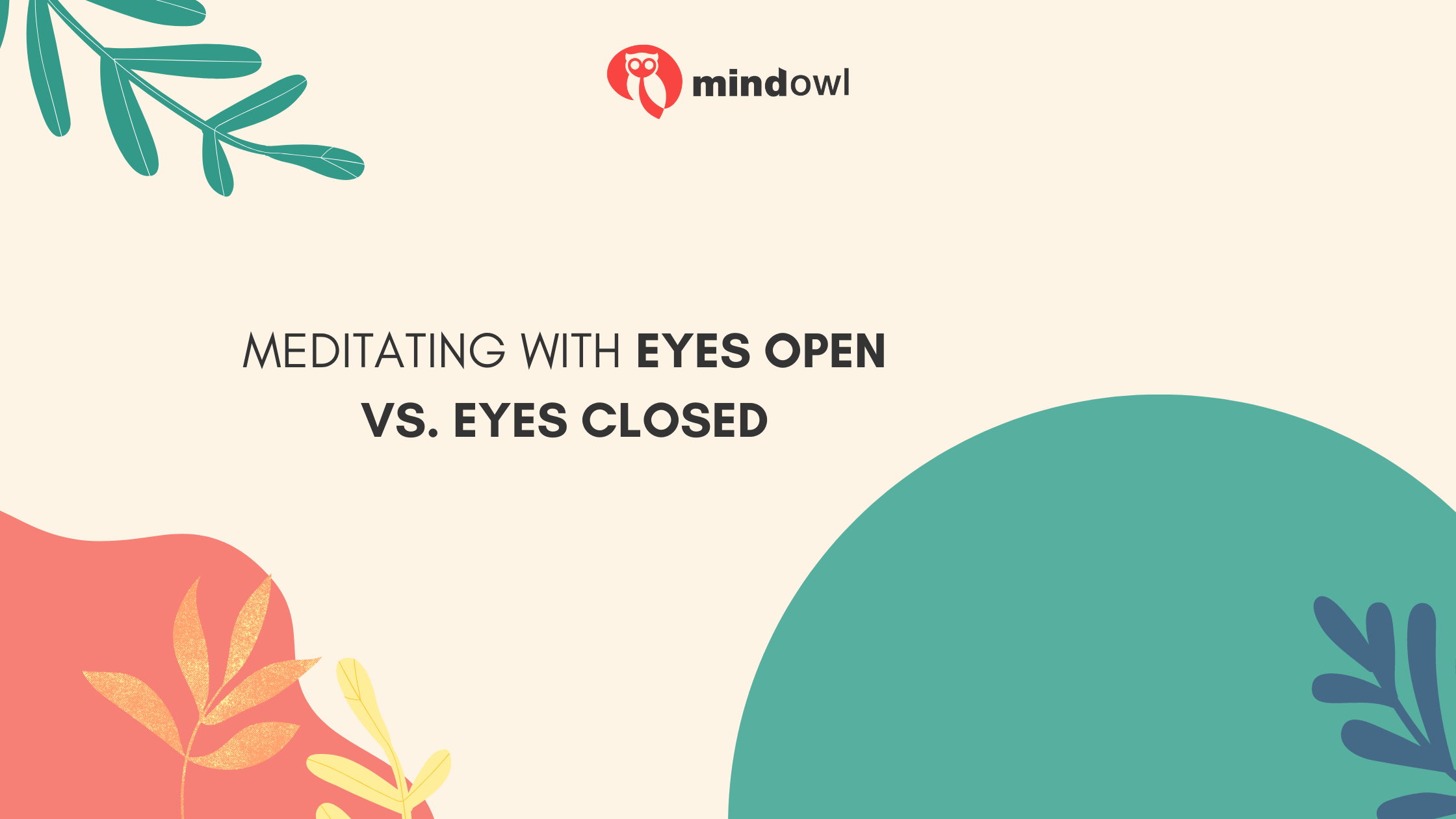Traditionally, meditation is often associated with closed eyes, a method that helps to minimize external distractions, allowing for deeper introspection and relaxation. This approach is particularly beneficial for beginners, as it aids in focusing inward and cultivating a sense of inner peace. However, open-eye meditation, rooted in Tibetan and Zen traditions, presents an alternative that integrates mindfulness into daily life. By maintaining a soft gaze, practitioners can remain connected to their surroundings, fostering a state of alertness and presence that combats drowsiness and enhances concentration.
In this blog, we will explore the unique benefits and challenges of both methods, offering insights into how they can be adapted to suit individual needs and preferences. Whether you’re drawn to the introspective depth of closed-eye meditation or the mindful engagement of open-eye practice, understanding the nuances of each can enrich your meditative journey. Join us as we uncover the transformative potential of meditation, both with eyes wide open and gently closed, inviting you to experiment and discover the approach that resonates most deeply with you.

Key Takeaways
- Meditating with closed eyes helps reduce distractions and increase focus on inner thoughts, leading to deeper relaxation.
- Open-eye meditation connects you with your surroundings, increasing alertness by 20% and making it easier to stay mindful in daily activities.
- Choosing a focal point during open-eyed meditation can help maintain focus and enhance external awareness.
- Experimenting with both techniques is vital to finding what best suits your personal goals and enhances your meditative experience.
Understanding Different Meditation Techniques
Meditation techniques vary, impacting focus and awareness. Eye position plays a crucial role in differentiating these techniques.
Importance of eye position in meditation
Eye position plays a crucial role in meditation, influencing both focus and awareness. Closed-eye meditation encourages deep relaxation and internal focus, helping meditators to shut out external distractions.
This technique is ideal for those seeking stress relief or a profound inner journey. Keeping the eyes closed can lead to a more intense connection with one’s thoughts and feelings, providing a peaceful escape from the outside world.
Conversely, open-eye meditation connects practitioners to their surroundings, cultivating mindfulness that extends beyond quiet moments of stillness. Originating from Tibetan Buddhist practices, this method involves keeping the eyes partially open and looking downwards at a 45-degree angle.
It teaches that calmness and clarity of mind are achievable even during daily activities. Practising with open eyes helps maintain alertness and prevents drowsiness, making it easier for individuals to integrate meditative techniques into their everyday lives.
Common techniques: eyes closed and open
Understanding the role of eye position helps us explore common meditation practices: eyes closed and open. With eyes closed, many find a deeper inner focus, which can lead to increased relaxation and reduced distractions.
This technique often feels more natural for those aiming for an inward journey or dealing with stress and anxiety. It aligns well with styles like body scan meditation, where internal awareness is key.
Meditating with your eyes open brings a different set of benefits. Techniques like Trataka or Candle Gazing Meditation keep the practitioner alert while focusing on an external object.
This practice enhances external awareness and prevents falling asleep during meditation – a frequent issue when meditating with closed eyes. Open-eye methods prove practical in daily life activities, allowing one to stay present and mindful even outside formal practice settings.
Benefits of Meditating with Eyes Closed
Meditating with eyes closed reduces distractions, promoting deeper internal focus. It also facilitates better relaxation by shutting out external stimuli.
Reduced distractions
Keeping your eyes closed during meditation can significantly cut down on distractions. This technique helps you turn your attention inward, making it easier to concentrate on your breath or focus point.
Without external visual stimuli, your mind is less likely to wander, allowing for a deeper and more fruitful practice.
This increased focus leads naturally to enhanced internal awareness. As distractions fade away, you might find yourself slipping into a state of relaxation more smoothly than before.
Next, we’ll explore how this heightened internal focus contributes to better overall relaxation in your meditation sessions.
Increased internal focus
Closing your eyes during meditation helps you turn your attention inward. This technique allows for a deep sense of focus on your inner self. Without the visual distractions of the outside world, you can better connect with your thoughts and feelings.
It’s an effective way to enhance self-awareness and understand your emotions more clearly.
Studies suggest that meditating with closed eyes aids in memory consolidation. This happens because it reduces attention to environmental stimuli, allowing the brain to process and store new information more efficiently.
By focusing inward, you cultivate a mental space where creativity and insight can flourish, making it easier to tackle stress or anxiety with greater clarity.
Better relaxation
Meditating with eyes closed often leads to an enhanced state of relaxation. This technique helps in reducing distractions, allowing the mind to dive deep into tranquillity. The practice fosters a deeper sense of inner peace as it strengthens and purifies the mind.
People find they can let go of stress more easily, making room for calmness.
Focusing on one’s breath becomes effortless when keeping their eyes closed during meditation. This simplicity aids in achieving better sleep quality and nurtures a peaceful mental environment.
As relaxation deepens, individuals frequently report feeling more refreshed and connected with themselves post-meditation.
Benefits of Meditating with Eyes Open
Meditating with eyes open increases external awareness. It enhances alertness and is easier to practice in daily life.
Increased external awareness
Practising meditation with your eyes open can enhance your awareness of the surrounding environment. Light entering your eyes helps keep you connected to the present moment, making it easier to maintain open-hearted awareness.
This technique ensures that all senses stay alert, providing a unique experience of being fully engaged with the external world.
Keeping your eyes open during meditation may challenge you at first, but it allows for an enriched sense of connection to everything around you. You become more attentive and receptive to stimuli, which can improve focus and mindfulness in daily activities.
This approach bridges the gap between traditional seated practice and the demands of everyday life, helping you stay awake and aware no matter where you are or what you’re doing.
Enhanced alertness
Building upon increased external awareness, keeping your eyes open during meditation can significantly boost alertness. Studies suggest a noticeable 20% increase in alertness for those who choose this method, making it an excellent choice for anyone struggling with sleepiness during their practice.
This approach helps you stay more awake and focused, seamlessly blending meditation into everyday moments where full attention is required.
Meditating with your eyes wide opens the door to being fully present in the here and now. It trains your mind to remain alert while still, sharpening your ability to notice details without getting distracted.
Whether you’re meditating or going about daily tasks, this heightened state of consciousness ensures you’re always at the top of your game, ready to tackle challenges head-on.
Easier to practice in daily life
Meditating with eyes open can make it easier to integrate the practice into your daily routine. This technique aligns with the traditions of Tibetan and Zen meditation, helping you stay alert and present throughout the day while avoiding drowsiness.
With increased external awareness, it becomes simpler to carry mindfulness into everyday activities, enhancing your ability to respond thoughtfully in various situations.
When practised regularly, open-eyed meditation can help cultivate a sense of calm and focus amidst the busyness of life. Additionally, research suggests that meditating with eyes open may support better sleep quality.

Tips for Practicing Open-Eyed Meditation
Relax your gaze and choose a focal point to enhance your open-eyed meditation experience. To discover more practical guidance on meditating with eyes open, continue reading the blog!
Relax your gaze
Soften your gaze and allow your eyes to rest on a focal point. Keep them half-open or fully opened while meditating, looking slightly downward to reduce distractions. This gentle, relaxed gaze enhances external awareness and helps in maintaining focus during open-eyed meditation.
By relaxing your gaze, you can experience the present moment with all senses equally engaged, deepening the meditative experience.
Ensure that the eyelids are soft as you maintain a gentle, unfocused visual attention during open-eye meditation. Softening your gaze can help enhance alertness and create an anchor for mindfulness in daily activities beyond formal meditation practice.
Choose a focal point
When practising open-eyed meditation, it’s crucial to choose a focal point to maintain focus and avoid distractions. Many practitioners opt for a simple object such as a candle flame, a flower, or an image on the wall.
By fixing your gaze gently on this chosen focal point, you can cultivate inner peace and mindfulness while staying connected with your surroundings. This practice allows for increased external awareness while still honing in on your internal state.
Use visualization techniques
Enhance your open-eye meditation practice by incorporating visualisation techniques to deepen your focus. Visualisations can help you build a mental picture, such as envisioning a peaceful landscape or focusing on a specific chakra point.
By using visual cues, you can maintain external awareness while also cultivating inner tranquillity.
Additionally, advanced open-eyed meditation practices often integrate visualisations to facilitate deeper mindfulness and concentration. This approach allows practitioners to explore the benefits of both external awareness and internal calm simultaneously, making it an effective technique for those seeking a balanced meditation experience.
Choosing the Right Technique for You
Consider your meditation goals and experiment to find the technique that suits you best. It’s important to personalise your practice for optimal results.
Consider your goals
Identify your intention for meditation to determine whether you seek internal focus and relaxation or external awareness and alertness. Use your specific goals as a guide to choose the technique that aligns with your desired outcomes.
Whether it’s reducing distractions, finding ease in practising daily life, or connecting with open-hearted awareness, understanding your objectives will help you select the most suitable meditation method for your journey.
Experiment with different techniques considering what works best for achieving your aspirations within the practice of meditation. Tailoring your approach based on individual needs can enhance the overall experience and effectiveness of meditative practices tailored specifically to benefit you.
Experiment and find what works best for you
Consider your goals when deciding whether to meditate with your eyes open or closed. Reflect on your personal preferences and the outcomes you wish to achieve through meditation, such as reducing distractions, increasing alertness, or enhancing internal focus.
Experiment with both techniques to find what aligns best with your objectives and provides the most effective results for you. Take into account the fact that meditating with eyes open can significantly increase alertness by 20%, while closing your eyes may lead to better relaxation and reduced external distractions.
Embrace a trial-and-error approach to identify which method brings about the desired mental state and fits seamlessly into your daily routine without judgment.
Conclusion
Meditating with eyes open or closed offers unique advantages, catering to individual preferences and meditation goals. Whether seeking heightened inner focus or increased external awareness, both techniques have their benefits.
Understanding these differences and experimenting with each method can enhance your meditation experience. Ultimately, the effectiveness of meditating with eyes open or closed differs for everyone; finding what works best for you is key to a fulfilling practice.
FAQs
1. What’s the difference between meditating with your eyes open and closed?
Meditating with your eyes open, often seen in practices like Zen Buddhism or Zazen, focuses on maintaining a soft gaze to stay present. Closing your eyes during meditation typically helps concentrate on inner experiences and can aid in reducing distractions.
2. Can keeping my eyes open during meditation improve my focus?
Yes, some people find that keeping their eyes slightly open helps maintain alertness and prevents them from dozing off. This method allows you to be aware of the moment without getting too caught up in thoughts.
3. Is it easier to meditate with my eyes closed?
Many find closing their eyes makes it easier to turn their attention inward and focus on their breath or internal states. It can also help create a sense of calm by blocking out visual stimuli.
4. Do I have to choose one way to meditate all the time?
Not at all! Meditation comes in many forms, so feel free to experiment with both methods – open-eye meditation and closed-eye meditation -until you find what works best for you.
5. How does meditating with my eyes half-open work?
Keeping your eyes half-open involves focusing your gaze on a single point such as a blank wall or object which may facilitate concentration while helping you stay connected to your surroundings.
6. Can practising one method over the other help me sleep better?
Some individuals report that practising closed-eye meditation before bed helps them relax more deeply leading to improved sleep quality. However, this varies from person to person, and experimenting with both techniques can help you discover what best aids your sleep patterns.
MindOwl Founder – My own struggles in life have led me to this path of understanding the human condition. I graduated with a bachelor’s degree in philosophy before completing a master’s degree in psychology at Regent’s University London. I then completed a postgraduate diploma in philosophical counselling before being trained in ACT (Acceptance and commitment therapy).
I’ve spent the last eight years studying the encounter of meditative practices with modern psychology.

